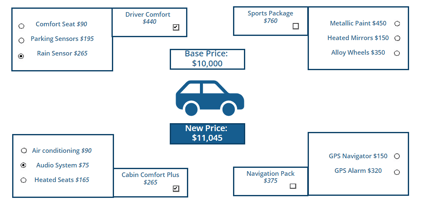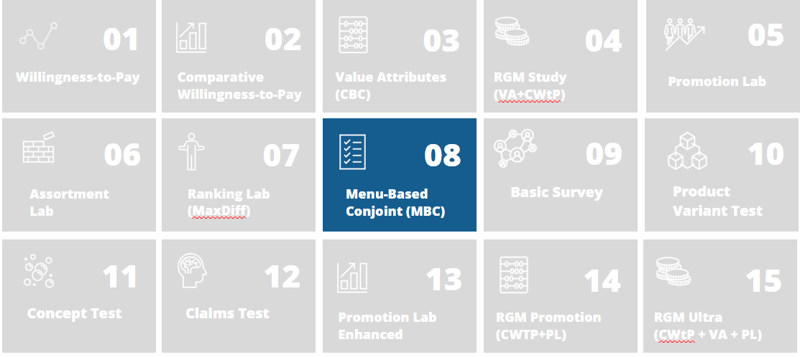Revolutionizing Automotive Pricing Strategies with MBC Analysis
 PriceBeam
·
3 minute read
PriceBeam
·
3 minute read

Introduction to Menu-Based Conjoint Analysis
In the dynamic and competitive realm of the automotive industry, grasping consumer preferences and effectively optimizing pricing strategies is not just an advantage, but a necessity for survival and growth. Enter Menu-Based Conjoint (MBC) analysis, an evolution in market research techniques that offers a deeper understanding of consumer decision-making, particularly in customizable product scenarios.
Theoretical Foundations and Evolution
The genesis of MBC lies in traditional conjoint analysis, which itself is a blend of statistical science and psychological insight. Traditional conjoint analysis has long been the go-to method for deciphering how consumers value various attributes of a product or service. It involves presenting consumers with hypothetical scenarios where they must choose between different products, each characterized by a distinct mix of features. These choices then offer insights into the relative value placed on each attribute by the consumer.
MBC, however, takes this foundational approach and elevates it to a level of complexity and realism that mirrors actual market conditions more closely. Recognizing that consumer decisions, especially in the automotive sector, are rarely black and white, MBC introduces a scenario where choices are not limited to single products. Instead, it presents a 'menu' of options and features, enabling consumers to mix and match in a way that more closely resembles real-life purchasing decisions. This approach is particularly adept at handling the multifaceted nature of consumer decisions in the automotive industry, where a car purchase involves considering numerous variables such as model, engine type, color, technology features, and additional luxury options.
Challenges Necessitating an MBC Study in the Automotive Industry
The automotive sector, a complex and ever-evolving industry, confronts a myriad of challenges that make the application of Menu-Based Conjoint (MBC) analysis not only beneficial but essential. These challenges span across consumer behaviour, technological innovation, competitive dynamics, and economic factors, each adding layers of complexity to decision-making processes in the industry.
Consumer Behaviour and Expectations
Today’s automotive consumers are more informed, discerning, and demanding than ever before. They seek vehicles that not only meet their functional needs but also align with their lifestyle, values, and identity. This shift in consumer behaviour has led to an increased demand for customization and personalization in vehicles. Consumers are looking for options that range from basic functional attributes like fuel efficiency and safety features to more sophisticated elements like advanced infotainment systems, connectivity, and driver-assist technologies. Understanding the nuanced preferences and willingness to pay for these diverse features is a significant challenge that MBC can address by providing detailed insights into consumer valuation of each attribute.
Technological Advancements and Innovation
The rapid pace of technological advancement in the automotive industry adds another layer of complexity. Electric vehicles (EVs), autonomous driving, connectivity, and AI are transforming the way cars are built and used. As these technologies evolve, automotive companies face the challenge of integrating them into their models in a way that appeals to consumers and justifies the price point. MBC studies can help in understanding how consumers value these emerging technologies and their impact on purchasing decisions.
Economic Factors and Pricing Pressure
Economic factors such as fluctuating raw material costs, changes in taxation and regulatory policies, and shifts in consumer purchasing power play a significant role in the automotive industry. These factors create pricing pressures and demand elasticity challenges. In such an environment, understanding the price sensitivity of consumers towards different vehicle attributes and features becomes vital. MBC analysis can shed light on how changes in price can affect consumer choice and demand, allowing companies to make informed decisions on pricing strategies.
Extended Relevance Across Industries
MBC's utility extends well beyond the automotive industry, offering valuable insights in sectors where customization and complex feature combinations are common. This includes consumer electronics, telecommunications, real estate, hospitality, healthcare, and even bespoke services like luxury travel and personalized education. In each of these sectors, MBC helps in deciphering consumer preferences for specific features, guiding pricing strategies, product development, and service offerings. For instance, in healthcare, understanding patient preferences for treatment options can lead to more patient-centric care models. In luxury travel, MBC can determine the most appealing aspects of personalized travel experiences, aiding in creating tailor-made packages that resonate with high-end clients.
Using demo data understand correlation between each menu item

In-Depth Process of Conducting an MBC Study with PriceBeam
The process of executing an MBC study with PriceBeam is detailed and multifaceted. It commences with a meticulous identification of key attributes and levels pertinent to the product. In the automotive industry, this encompasses a wide spectrum from performance and efficiency to aesthetic appeal and brand perception. Participants in the study are then presented with a series of choice tasks that mimic the experience of configuring a product with various features and options. This immersive process not only simulates real-life buying scenarios but also captures comprehensive data on consumer preferences and behaviours. PriceBeam's advanced analytical techniques then dissect this data, yielding insights on how different features and pricing models influence consumer decisions. These insights are critical for businesses to fine-tune their pricing strategies, ensuring they align with consumer demands while maximizing market potential.
Suggested Webinar➡️ Optimizing Prices for the Automotive Industry
Conclusion
Menu-Based Conjoint analysis, especially when utilized through sophisticated platforms like PriceBeam, offers an unprecedented depth of understanding into consumer preferences and price sensitivity. In industries where product customization and a multitude of feature options are standard, such as in the automotive sector, it becomes an invaluable tool for pricing optimization. MBC enables companies to strategically price their products, tailor their offerings to meet specific customer demands, and maintain a competitive edge in the ever-changing market landscape. By leveraging MBC, automotive companies can make informed, data-driven decisions that resonate with their target audience, resulting in increased sales, enhanced customer satisfaction, and a strengthened market position.

Want to learn more? Book a call with one of our experts and see MBC in action ⬇️
.png?width=400&height=100&name=PBLogoTransparent%20(1).png)




